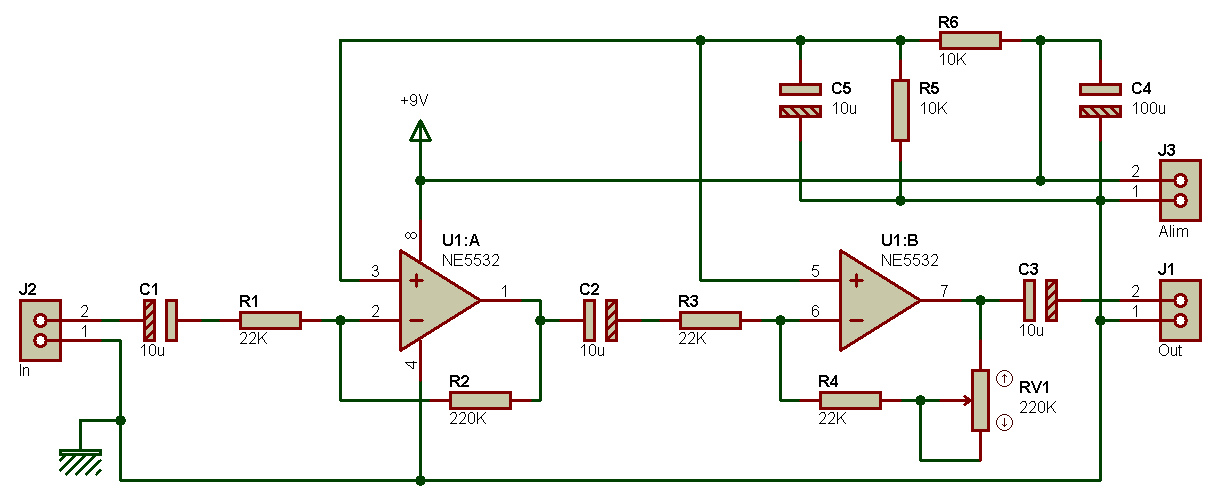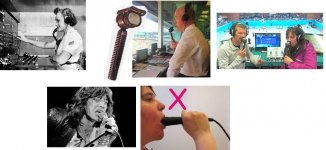So I've build this preamp for an electret mic:

Next I build this amp for my dynamic mic:

So I would like to place them like this:

The brown square is my desk and the yellow one is the play area of my brother the only problem is that he make a lot of noise when playing so Is ther a way to remove all noise picked by the electret mic from the dynamic mic ? I seen this schematic:

(A Noise Cancelling Microphone)
but how do I connect it ?
Thank in advance

Next I build this amp for my dynamic mic:

So I would like to place them like this:

The brown square is my desk and the yellow one is the play area of my brother the only problem is that he make a lot of noise when playing so Is ther a way to remove all noise picked by the electret mic from the dynamic mic ? I seen this schematic:

(A Noise Cancelling Microphone)
but how do I connect it ?
Thank in advance
Won't work, though understanding "why" will take some time.
The microphones must be very well matched and close together, much less than one wavelength of sound in air. Wavelength of sound in air varies from 10 feet for deep bass to 1 inch for high treble. So if brother had a large bass drum, you might be able to cancel the boom but not the thwack. Most of the annoying sounds are mid-high frequency, short wavelengths, and "close" is at most a few inches.
The Time-Honored way to bring the talker above the background racket is CLOSE-miccing. When you had many telephone operators side by side, they used chest-strap mikes with a horn to their mouth. When announcing loud cricket/football matches, the BBC used a special mike made to almost touch the mouth. The bald guy is in a booth and not working close, the top-edge is supposed to rest on your mustache like the two hockey announcers seem to be doing. And of course the classic rock-n-roll kiss-the-mike position.
Bringing the mike from 4 inches to 1 inch gets nearly 4X as much of you but about the same of your brother. When you correct the over-loud, your brother is 4X softer. This is often a big help.
Getting closer than 1" is little better because your mouth is about 1" across.
Going inside the mouth "would" reduce the roar of the crowd/brother but speech is a lot about lip-action and the sound inside the mouth is VERY different from normal speech. This has been done for special cases (underwater divers) where the listener trains to understand the strangeness. (And a mini-mike, not an SM-58.)
Another extreme case: mask mike.
The microphones must be very well matched and close together, much less than one wavelength of sound in air. Wavelength of sound in air varies from 10 feet for deep bass to 1 inch for high treble. So if brother had a large bass drum, you might be able to cancel the boom but not the thwack. Most of the annoying sounds are mid-high frequency, short wavelengths, and "close" is at most a few inches.
The Time-Honored way to bring the talker above the background racket is CLOSE-miccing. When you had many telephone operators side by side, they used chest-strap mikes with a horn to their mouth. When announcing loud cricket/football matches, the BBC used a special mike made to almost touch the mouth. The bald guy is in a booth and not working close, the top-edge is supposed to rest on your mustache like the two hockey announcers seem to be doing. And of course the classic rock-n-roll kiss-the-mike position.
Bringing the mike from 4 inches to 1 inch gets nearly 4X as much of you but about the same of your brother. When you correct the over-loud, your brother is 4X softer. This is often a big help.
Getting closer than 1" is little better because your mouth is about 1" across.
Going inside the mouth "would" reduce the roar of the crowd/brother but speech is a lot about lip-action and the sound inside the mouth is VERY different from normal speech. This has been done for special cases (underwater divers) where the listener trains to understand the strangeness. (And a mini-mike, not an SM-58.)
Another extreme case: mask mike.
Attachments
Last edited:
Place two mics back to back and out of phase. Ambient sound will be picked up by both mics and cancelled due to the phase difference. Any loud noise on one mic will get through.
Think Helicopter microphones, that is how they work.
Think Helicopter microphones, that is how they work.
Is it an other way like placing two dynamic mic pointing towards me like this:
And remove all nois around the red cone
Code:
Mic A Mic B
[COLOR=Red]|[/COLOR]\ /[COLOR=Red] |[/COLOR]
[COLOR=Red]\[/COLOR] \ / [COLOR=Red]/[/COLOR]
[COLOR=Red]\[/COLOR] \ / [COLOR=Red]/[/COLOR]
[COLOR=Red] \[/COLOR] \ / [COLOR=Red]/[/COLOR]
[COLOR=Red]\[/COLOR] \ / [COLOR=Red]/[/COLOR]
[COLOR=Red]\ [/COLOR] \ / [COLOR=Red]/[/COLOR]
[COLOR=Red] |[/COLOR] Me [COLOR=Red]|[/COLOR]- Status
- Not open for further replies.
